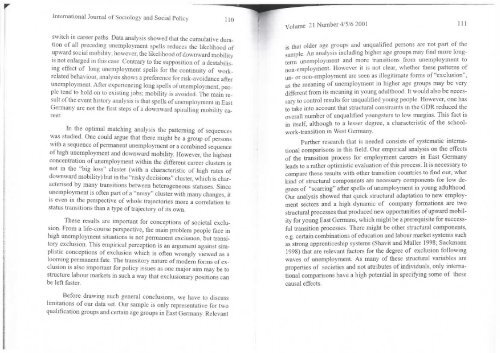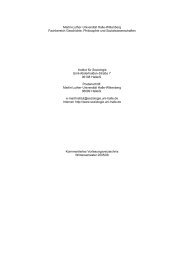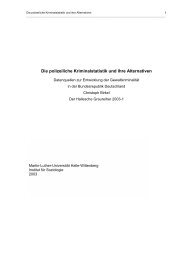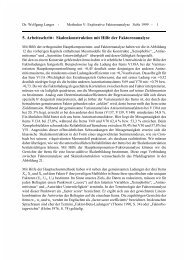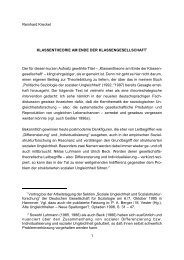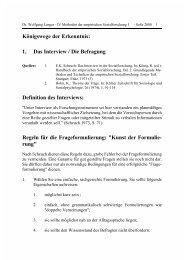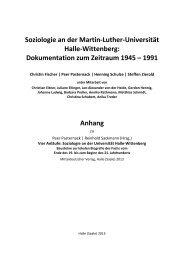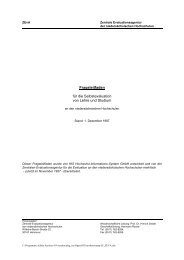EXPLAINING SOCIAL EXCLUSION - Institut für Soziologie
EXPLAINING SOCIAL EXCLUSION - Institut für Soziologie
EXPLAINING SOCIAL EXCLUSION - Institut für Soziologie
You also want an ePaper? Increase the reach of your titles
YUMPU automatically turns print PDFs into web optimized ePapers that Google loves.
International Journal of Sociology and Social Policy<br />
switch in career paths. Data analysis showed that the cumulative duration<br />
of all preceding unemployment spells reduces the likelihood of<br />
upward social mobility; however, the likelihood of downward mobility<br />
is not enlarged in this case. Contrary to the supposition of a destabilising<br />
effect of long unemployment spells for the continuity of workrelated<br />
behaviour, analysis shows apreference for risk-avoidance after<br />
unemployment. After experiencing long spells of unemployment, people<br />
tend to hold on to existing Jobs; mobility is avoided. The main result<br />
of the event history analysis is that spells of unemployment in East<br />
Germany are not the first steps of a downward spiralling mobility career.<br />
In the optimal matching analysis the patterning of sequences<br />
was studied. One could argue that there might be a group of persons<br />
with a sequence of permanent unemployment or a combined sequence<br />
of high unemployment and downward mobility. However, the highest<br />
concentration of unemployment within the different career clusters is<br />
not in the "big loss" cluster (with a characteristic of high rates of<br />
downward mobility) but in the "risky decisions" cluster, which is characterised<br />
by many transitions between heterogeneous statuses. Since<br />
unemployment is often part of a "noisy" cluster with many changes, it<br />
is even in the perspective of whole trajectories more a correlation to<br />
Status transitions than a type of trajectory of its own.<br />
These results are important for conceptions of societal exclusion.<br />
From a life-course perspective, the main problem people face in<br />
high unemployment situations is not permanent exclusion, but transitory<br />
exclusion. This empirical perception is an argument against simplistic<br />
conceptions of exclusion which is often wrongly viewed äs a<br />
looming permanent fate. The transitory nature of modern forms of exclusion<br />
is also important for policy issues äs one major aim may be to<br />
structure labour markets in such a way that exclusionary positions can<br />
be left faster.<br />
Volume 21 Number 4/5/6 2001 111<br />
is that older age groups and unqualified persons are not part of the<br />
sample. An analysis including higher age groups may find more longterm<br />
unemployment and more transitions from unemployment to<br />
non-employment. However it is not clear, whether these patterns of<br />
un- or non-employment are seen äs illegitimate forms of "exclusion",<br />
äs the meaning of unemployment in higher age groups may be very<br />
different from its meaning in young adulthood. It would also be necessary<br />
to control results for unqualified young people. However, one has<br />
to take into account that structural constraints in the GDR reduced the<br />
overall number of unqualified youngsters to low margins. This fact is<br />
in itself, although to a lesser degree, a characteristic of the schoolwork-transition<br />
in West Germany.<br />
Further research that is needed consists of systematic international<br />
comparisons in this field. Our empirical analysis on the effects<br />
of the transition process for employment careers in East Germany<br />
leads to a rather optimistic evaluation of this process. It is necessary to<br />
compare these results with other transition countries to find out, what<br />
kind of structural components are necessary components for low degrees<br />
of "scarring" after spells of unemployment in young adulthood.<br />
Our analysis showed that quick structural adaptation to new employment<br />
sectors and a high dynamic of Company formations are two<br />
structural processes that produced new opportunities of upward mobility<br />
for young East Germans, which might be a prerequisite for successful<br />
transition processes. There might be other structural components,<br />
e.g. certain combinations of education and labour market Systems such<br />
äs strong apprenticeship Systems (Shavit and Müller 1998; Sackmann<br />
1998) that are relevant factors for the degree of exclusion following<br />
waves of unemployment. As many of these structural variables are<br />
properties of societies and not attributes of individuals, only international<br />
comparisons have a high potential in specifying some of these<br />
causal effects.<br />
Before drawing such general conclusions, we have to discuss<br />
limitations of our data set. Our sample is only representative for two<br />
qualification groups and certain age groups in East Germany. Relevant


